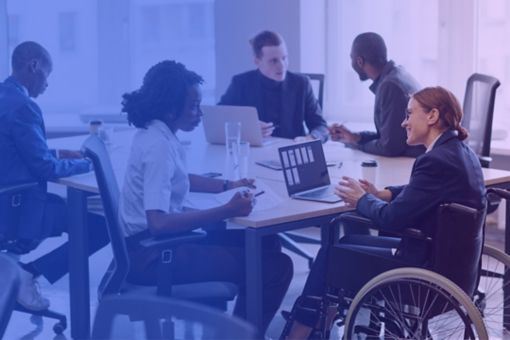KPMG offers comprehensive Organisational Transformation Solutions through a multifaceted approach, covering an organisation's key foundational and operational levers. In today's fast-paced and dynamic business world, it is essential to remain agile by adapting a continuous transformation journey.
We enable leaders to leverage Organisational Design and Transformation expertise in the journey of continuous growth and evolution of the organisation. The core foundational elements of transformational design and implementation, including Organisation Structure, Job Grading, Workforce Plan, Cultural Transformation, and HR Transformation, are all embedded within our Organisational Transformation solutions.
Our team of subject matter experts have extensive experience working with organisations of different sizes and industries on a worldwide basis. This has given us an understanding of the nuances and sensitivities involved in transformations, including a complex business model and uncertain industry patterns.
Organisational Design
What issues are our clients facing?
- The organisational structure needs to be reshaped, creating a leaner model and more efficient reporting lines and decision-making processes.
- Lack of clarity in the decision-making process and need for authority matrix.
- Lack of clear organisational vision and alignment between the leadership team's senior and middle management in business strategy and achieving organisational goals. This results in difficulty reaching organisational goals and achieving the desired future state.
- A need to be less complex and have a clear line of sight from strategy to execution.
What do we do to help clients tackle these challenges?
- Our team comprises organisational design experts who work with organisations at any stage, from start-ups to long-established organisations. They use the KPMG Organisational Design for Performance Framework to ensure an organisation has the proper structure and reporting lines to support its overall vision and mission.
- We facilitate Stakeholders’ alignment on organisational structure, decision-making process, mission, vision, and values.
- We support organisations by creating comprehensive roles, responsibilities, and job descriptions.
- We help organisations create transparent decision-making and authority matrix.
What are the benefits of Organisational Design?

Improved Efficiency and Effectiveness
Streamline operations, eliminate redundancies, and clarify roles & responsibilities for smoother workflows.
Increased Employee Engagement and Satisfaction
Foster a sense of ownership and belonging with better alignment and communication.
Improved Decision-Making
Centralise crucial information and empower teams for faster, more informed decisions.Job Grading
What issues are our clients facing?
- Inconsistent pay for similar job roles and many outliers outside of salary ranges or salary ranges are non-existent.
- A desire to understand gender-equal pay and equal pay for equal jobs.
- The risk of overpaying for certain roles and underpaying others leads to higher payroll costs and wasted resources.
- Lack of clarity about the relative worth of jobs makes career progression and development paths unclear.
What do we do to help clients tackle these challenges?
- Our team consists of professionals certified to use the KPMG sKale Job Grading Methodology to conduct job grading exercises for our clients.
- We help organisations increase objectivity, transparency and fairness in remuneration philosophy and career progression through job grading.
- Through a clear understanding of the value, complexity, and impact of different job roles, we help clients establish job levels that support a rational pay structure across the organisation.
- We help organisations establish a hierarchical structure across job roles in situations like M&A and rapid growth.
What are the benefits of Job Grading?

Pay Equity and Internal Equity
Ensure that similar jobs are compensated fairly and equitably based on their relative worth to the organisation. Employees can see how their roles compare to others and understand the basis for decisions regarding pay and promotions.
Improved Talent Management
Facilitate better recruitment, performance management, and succession planning.
Reduced Legal Risks
Mitigate potential discrimination claims by having a documented and defensible job grading system. Prevent pay discrimination and ensure that employees are compensated fairly for their contributions.Strategic Workforce Planning
What issues are our clients facing?
- Workforce planning is focused on short-term initiatives, and there needs to be more alignment between planning and business goals.
- The organisation is not staffed efficiently: it does not forecast its workforce needs or the supply of talent that is or will be available.
- Lack of evidence-based approach in making decisions about workforce supply and demand.
- Uncertainty about the right skillset in the organisation at present and for the future.
What do we do to help clients tackle these challenges?
- We help organisations forecast and plan by conducting a systemic workforce assessment highlighting capacity and capability gaps and identifying whether the ‘Buy’ (recruitment) or ‘Build’ (train & develop) strategy is appropriate.
- In association with the business requirements for growth, we identify the type of soft and hard skills and their levels that are crucial to meeting these needs.
- We integrate a systematic organisational process encompassing proactive workforce planning to avoid talent and skills surpluses or shortages.
- We can use a Workforce Projection Model to identify capacity gaps. Proof of identified capability and capacity gaps helps determine where to focus training and skills development so that the right number of people with the right skills at the proper levels are in place at the right time for the organisation to succeed.
What are the benefits of Strategic Workforce Planning?

Enhanced Strategic Alignment
Alignment of actions (i.e. recruitment, succession planning, employee reskilling, horizontal transfers etc.) to achieve business strategy.
Reduced Talent Gaps and Risks
Proactively address future skill needs and build a sustainable workforce.
Improved Talent Acquisition and Retention
Attract and retain top talent by aligning workforce planning with the overall business strategy.Culture Transformation
What issues are our clients facing?
- The organisation is experiencing a change and needs to shift from its current culture to its desired culture.
- Lack of understanding of actions which need to be done to achieve a desired culture.
- Misaligned values and lack of trust and open communication create information silos, hindering collaboration and decision-making, leading to slower processes and missed opportunities.
- An antagonistic culture can permeate outwards, damaging the organisation’s reputation and leading to customer dissatisfaction and loss of business.
What do we do to help clients tackle these challenges?
- We help organisations assess their current culture, define their desired culture, and propose actions to bridge the identified gaps between the as-is and to-be cultures.
- Support organisations in agreeing on the direction of culture change as per the business strategy, exploring benefits and possible pain points due to the change, and ensuring leadership alignment and engagement in the transformation.
- Develop a consistent and impactful communication strategy and plan whilst fostering leadership buy-in and support to cascade the vision and case for culture change to the whole organisation.
- Design the execution process for culture transformation, including specific Culture KPIs to measure success, integration with other transformation initiatives and clearly defined leadership actions.
What are the benefits of Culture Transformation?

Enhanced Employee Engagement
A positive culture fosters employee engagement, leading to increased motivation, productivity, and satisfaction.
Improved Innovation and Agility
A culture that encourages collaboration, thinking out of the box, and cognitive diversity leads to increased innovation and adaptability to changing market dynamics.
Stronger Employer Brand
A positive and values-driven culture attracts top talent and strengthens your employer brand in the competitive recruitment market.HR Transformation
What issues are our clients facing?
- Indications of overstaffing/understaffing in the HR department. Consideration of restructuring and reorganisation of HR department.
- HR is not set up to succeed as a forward-moving strategic HR department.
- Misaligned HR processes and policies.
- Lack of clear SOPs which support the mapping of the recruitment process, career management and internal promotions.
What do we do to help clients tackle these challenges?
- We focus on HR Optimisation and improving efficiency, productivity, and performance by identifying gaps in HR practices to improve organisational success.
- We collect an extensive spectrum of observations related to HR procedures and policies and provide a deep gap analysis according to the KPMG Organisational Design for Performance Framework.
- Define the Current Operating Model and Target Operating Model for the HR function. Provide clear guidance (i.e., recommendations and an action plan with top priorities) on bridging identified gaps.
- We ensure that all immediate concerns are addressed, and HR policies and SOPs are all updated or created (e.g., recruitment process SOP).
- Build and design implementation roadmaps to achieve a desired future state.
What are the benefits of HR Transformation?

Sustainable Transformation
Continuous optimisation based on data insights ensures long-term HR effectiveness.
Data-driven Decision Making
Insights from gap analysis and SOP implementation inform strategic HR decisions.
Stronger Business Alignment
A well-functioning HR function aligned with business goals drives overall organisational success.Talent Acquisition and Executive Profiling
What issues are our clients facing?
- Limitations and time constraints in finding top talent to join their organisation.
- Lack of access to a specialised talent pool in terms of geography and industry.
- Lengthy candidate screening processes.
- Costs related to maintaining internal recruitment structures within their organisation.
What do we do to help clients tackle these challenges?
- We champion in delivering a data-driven specialised talent search process to attract a representative pool of candidates, who would be invaluable contenders for each vacancy presented to us by the client.
- We profile candidates assessing their personal competencies, whilst discussing and evaluating with them their career ambitions and motivations.
- We present our market observations and assist the client with the evaluation and selection process.
- We serve as leading advisors to boards of directors and leadership teams with customised talent solutions, adopting organisational transformation best practices ingrained with robust design, comms, evaluation, and quality measures.
What are the benefits of Talent Acquisition Advisory Services?

Competitive Advantage
A source of competitive advantage, of business value, and not only a service centre.
Talent Acquisition Advisory
Innovative end-to-end Talent Acquisition Advisory solutioning and reliability to secure fit-for-role hires.
Reporting
Consistent process status reporting.





